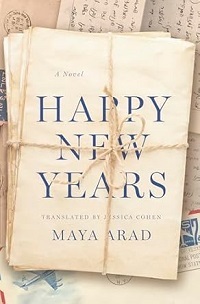Review of 'Happy New Years' by Maya Arad
Maya Arad is a leading author of Israeli fiction, but shedoesn’t live in Israel. Arad, who grew up in Kibbutz Nahal Oz, has been living inCalifornia for the last twenty years. The Hebrew Teacher, her collectionof three novellas−the first of her books to be translated into English−won theNational Jewish Book Award for Hebrew Fiction in Translation in January 2025. Nowreaders have the opportunity to read one of her novels in English.
 Happy New Years
by Maya Arad, translated by Jessica Cohen (New VesselPress, August 5, 2025) is the story of Leah, as told in yearly Rosh Hashanaletters sent to her classmates from a teacher’s college in Israel. Instead ofjust bearing good wishes for the upcoming Jewish New Year, each letter tellsthe story of Leash’s life during the previous 12 months, in exhaustive detail.
Happy New Years
by Maya Arad, translated by Jessica Cohen (New VesselPress, August 5, 2025) is the story of Leah, as told in yearly Rosh Hashanaletters sent to her classmates from a teacher’s college in Israel. Instead ofjust bearing good wishes for the upcoming Jewish New Year, each letter tellsthe story of Leash’s life during the previous 12 months, in exhaustive detail.The annual mail starts with a recap of the episodesmentioned in the letter dated the year before, to remind both recipients andthe novel’s readers of their importance in Leah’s life. An update on thesemilestones in Leah’s life follows, and then there is her news. Leah informs herfriends of developments in her love life, stories of her children growing up,and accounts of her career changes.
Her best friend, Mira, is the recipient of postscripts withfurther insights into Leah’s true feelings about where her life has taken her,complete with apologies and confessions. “To you I can write what is truly inmy heart, with no masks and guises,” Leah notes.
“I came to America on an educational mission, to teachJewish children who, one day, may themselves make Aliyah,” Leah writes in her1970 message. “I am living in the United States for now, and who knows what thefuture will bring?” Two years later, Leah mentions that she and her husband areconsidering Aliyah. “The circumstances are finally ripe for making asignificant change in our lives.” Yet her Aliyah plans fall through. “I’vebuilt a life for myself here that I’m unwilling and unable to walk away from,”she writes in 1986.
The yearly Rosh Hashana messages recount Leah’s ups anddowns, and one can see how she matures through the years. This epistolary novelsucceeds in telling her story, and readers are compelled to turn the pages tolearn whether she will find true love or successfully handle the challenges shefaces.
Still, there are parts of what Leah writes in the narrativethat will frustrate readers. Detailed reports of what it was like to fly in anairplane for the first time, an explanation of why Chicago is called ‘the WindyCity’, how daily life in America is easier because of dishwashers, and theadvantages of working with a computer–these elements show the passage of time butnot things anyone would naturally include in a Rosh Hashana letter.
Still, this is a minor observation as the overall format ofthe novel succeeds in telling a story of a woman’s life; her struggles, loves,and growth; the friendships she makes and the friendships she loses; and howone can still be an Israeli even while keeping a permanent residency overseas.
Leah ends each mail with a message marking her unwaveringoptimism about the Jewish New Year. “May it be a year full of dreams!” shewrites. “May it be a wonderful year, a magical year, a year of change andgrowth!” Readers will share Leah’s positive outlook on life with eageranticipation of her next Happy New Year letter.
Maya Arad is the author of twelve books of Hebrewfiction, as well as studies in literary criticism and linguistics. Born inIsrael in 1971, she received a PhD in linguistics from University CollegeLondon and for the past twenty years has lived in California where she iswriter in residence at Stanford University’s Taube Center for Jewish Studies.



